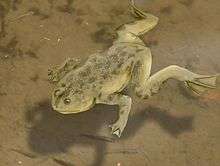Palaeobatrachus
Palaeobatrachus was a genus of primitive frogs from Europe that existed from the Thanetian to the middle Pleistocene period (Ionian Stage) (621-568ka), and possibly the Late Cretaceous. Although not closely related, it would have superficially resembled the present day African clawed toad Xenopus.
| Palaeobatrachus | |
|---|---|
 | |
| Palaeobatrachus gigas from Czech Republic | |
| Scientific classification | |
| Kingdom: | Animalia |
| Phylum: | Chordata |
| Class: | Amphibia |
| Order: | Anura |
| Family: | †Palaeobatrachidae |
| Genus: | †Palaeobatrachus Tschudi, 1839 |
| Species | |
| |
| Synonyms | |
|
Pliobatrachus | |
Description

Palaeobatrachus had a relatively broad skull the shape of a Gothic arch. Its body was relatively large, ranging from 8 to 10 centimetres (3.1 to 3.9 in) in length, and the female was usually larger than the male (sexual dimorphism).
Taxonomy
The Eocene genus Albionbatrachus was considered a synonym of Palaeobatrachus by Wuttke et al. (2012), but Roček et al. (2015) retained it as a separate taxon.[1][2][3]
The nominal species Palaeobatrachus occidentalis was described from material found in the Late Cretaceous-Early Paleocene of western North America,[4] but Roček (2013) questioned its generic attribution.[5]
Habitat and paleoecology
Its skeletal remains are plentiful in freshwater sediments in western Bohemia, in Geiseltal (west Germany) and in east Germany. They are sometimes preserved very well indeed, with impressions of internal organs, muscles, nerves, blood vessels and epidermis, and with traces of coloring. Tadpoles and eggs have also been found.
These frogs lived permanently in water. Their bag-shaped lungs, on the dorsal side of their body, enabled them to remain submerged for long periods. They inhabited through-drainage basins or swamps where brown coal deposits were formed. Like the African clawed toad, they probably lived on small crustaceans, insect larvae and small fish and themselves provided sustenance for many other animals.
The climatic change at the beginning of the Pliocene was a real catastrophe for Palaeobatrachus, which required warmth, and, being specialized, was unable to adapt itself to the altered conditions. Water-rich and warm environment that existed in the area of the Netherlands, acting as a refugium for Palaeobatrachus, made it possible for one species (P. eurydices) to survive in western europe as recently as the early Pleistocene.[6] In addition a species persisted in southern Russia until the mid Pleistocene.[1]
References
- Wuttke, M; Přikryl, T; Ratnikov, VY; Dvořák, Z; Roček, Z (September 2012). "Generic diversity and distributional dynamics of the Palaeobatrachidae (Amphibia: Anura)". Palaeobiodiversity and Palaeoenvironments. 92 (3): 367–395. doi:10.1007/s12549-012-0071-y. ISSN 1867-1594.
- Venczel, M; Codrea, V; Fărcaş, C (2013). "A new palaeobatrachid frog from the early Oligocene of Suceag, Romania". Journal of Systematic Palaeontology. 11 (2): 179–189. doi:10.1080/14772019.2012.671790.
- Roček, Z., Boistel, R., Lenoir, N., Mazurier, A., Pierce, S.E., Rage, J.-C., Smirnov, S.V., Schwermann, A.H., Valentin, X., Venczel, M., Wuttke, M., and Zikmund, T. 2015. Frontoparietal bone in extinct Palaeobatrachidae (Anura): its variation and taxonomic value. The Anatomical Record, 298:1848-1863. https://doi.org/10.1002/ar.23203
- Estes, R. and Sanchíz, B. 1982. New discoglossid and palaeobatrachid frogs from the Late Cretaceous of Wyoming and Montana, and a review of other frogs from the Lance and Hell Creek Formations. Journal of Vertebrate Paleontology 2:9-20.
- Roček, Z. 2013. Mesozoic and Tertiary Anura of Laurasia. Palaeobiodiversity and Palaeoenvironments, 93:397-439. https://doi.org/10.1007/s12549-013-0131-y
- Andrea Villa; Zbyněk Roček; Emanuel Tschopp; Lars W. Van Den Hoek Ostende; Massimo Delfino (2016). "Palaeobatrachus eurydices, sp. nov. (Amphibia, Anura), the last western European palaeobatrachid". Journal of Vertebrate Paleontology. 36 (6): e1211664. doi:10.1080/02724634.2016.1211664.
| Wikimedia Commons has media related to Palaeobatrachus. |
Further reading
- Benes, Josef (1979). Prehistoric Animals and Plants. Prague: Artia. p. 178.